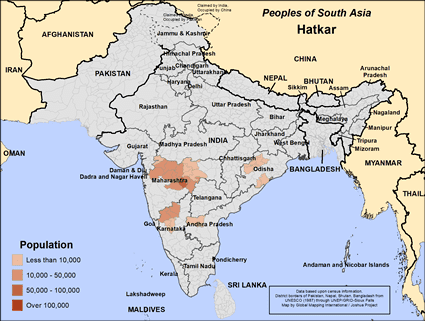 | ||
Hatkar is a caste found in Deccan region of India.
Contents
Etymology
The word Hatkar is popularly derived from the Marathi hat (हठ, "obstinacy") and kar (कर, "doer"), meaning "obstinate" or "stubborn". However, this etymology is fictitious, and the origin of the caste is uncertain.
S. B. Joshi traced the origin of the name to the word "Hatakara", meaning cattle herder and a synonym of Dhangar.
The Hatkar are also known by the names Bargir or Barga Dhangar. According to their lore, they were called such because they would only take a seven-hands long blanket and a bear-spear (barcha) while going on an expedition.
History
S. B. Joshi traced the ancestry of Hatkars (Hattikaras) to the "Patti-Jana" people who were settled to the south of Narmada river in the middle ages. He also traced the etymology of the word "Maratha" to "Mara-hatta", and theorized that the region was originally known as "Hatta-desa".
British writer Captain Fitzgerald, the Assistant Commissioner of Berar Province, noted that according to the Hatkar lore, the community migrated to from northern India to Deccan some time before the Nizam became the Subedar of Deccan. According to this account, the migration took place at the behest of kings of Delhi. The Ain-i-Akbari mentions a Hatkar force of 1,000 cavalry and 5,000 infantry. It also suggests that the Hatkars were driven westward across the Wardha River by the Gond people.
In 1819, the Hatkar leader Novsaji Naik rebelled against the Nizam's rule in the Nanded district. Also known as Naosaji, he held the forts of Nowah and Umerkhed, where he assembled a large number of Arab mercenary soldiers. The British-trained Nizam's contingent was called in to put down the rebellion.
Culture
There is an expression, "Dhangar's ram and Hatkar's flag". Meaning, the one who tends to ram and sheep is Dhangar, while one with a flag is Hatkar. The flag is sparrowtailed and is bi-coloured. The upper-half is yellow, and the second half is red.
Traditionally, the Hatkars are distinguished from other Dhangar by wearing a red turban, earring and a coarse blanket and carrying staff. Their women wear a considerable number of rings, necklaces, nose rings and ankle bangles.
Varna status
The Hatkar identify themselves as falling within the Kshatriya (warrior) varna in Hindu society. Deshastha Brahmin are employed as priests and serve the caste in their religious and ceremonial observances.
